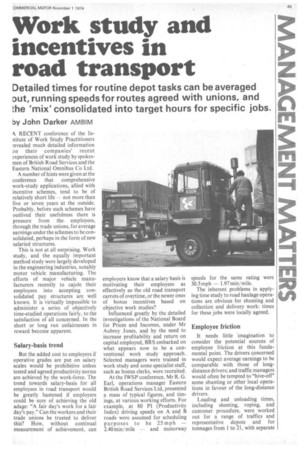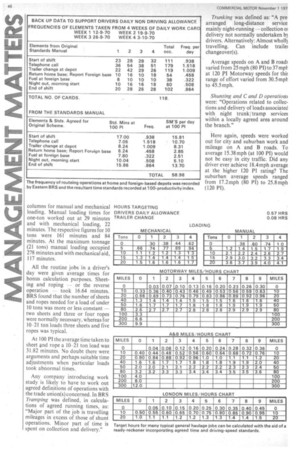Work study and incentives in road transport
Page 49

Page 50

Page 51

If you've noticed an error in this article please click here to report it so we can fix it.
Detailed times for routine depot tasks can be averaged out, running speeds for routes agreed with unions, and the 'mix' consolidated into target hours for specific jobs.
by John Darker AMBIM A RECENT conference of the InAitute of Work Study Practitioners revealed much detailed information on their companies' recent experiences of work study by spokesmen of British Road Services and the Eastern National Omnibus Co Ltd.
A number of hints were given at the conference that comprehensive work-study applications, allied with incentive schemes, tend to be of relatively short life — not more than five or seven years at the outside. Probably, before such schemes have outlived their usefulness there is pressure from the employees, through the trade unions, for average earnings under the schemes to be consolidated, perhaps in the form of new salaried structures.
This is not at all surprising. Work study, and the equally important method study were largely developed in the engineering industries, notably motor vehicle manufacturing. The efforts of major vehicle manufacturers recently to cajole their employees into accepting consolidated pay structures are well known. It is virtually impossible to administer a series of objectively time-studied operations fairly, to the satisfaction of all concerned. In the short or long run unfairnesses in reward become apparent.
Salary-basis trend
But the added cost to employers if operative grades are put on salary scales would be prohibitive unless tested and agreed productivity norms are achieved by the work-force. The trend towards salary-basis for all employees in road transport would be greatly hastened if employers could be sure of achieving the old adage: "A fair day's work for a fair day's pay." Can the workers and their trade unions be trusted to deliver this? How, without continual measurement of achievement, can employers know that a salary basis is motivating their employees as effectively as the old road transport carrots of overtime, or the newer ones of bonus incentives based on objective work studies?
Influenced greatly by the detailed investigations of the National Board for Prices and Incomes, under Mr Aubrey Jones, and by the need to increase profitability and return on capital employed, BRS embarked on what appears now to be a conventional work study approach. Selected managers were trained in work study and some specialist staff, such as bonus clerks, were recruited.
At the IWSP conference, Mr R. G. Earl, operations manager Eastern British Road Services Ltd, presented a mass of typical figures, and timings, at various working efforts. For example, at 80 PI (Productivity Index) driving speeds on A and B roads were assumed for scheduling purposes to he 25 mph — 2.40mintmile — and motorway speeds for the same rating were 30.5 mph 1.97 minI mile.
The inherent problems in applying time study to road haulage operations are obvious for shunting and collection and delivery work: times for these jobs were locally agreed.
Employee friction
It needs little imagination to consider the potential sources of employee friction at this fundamental point. The drivers concerned would expect average earnings to be comparable with those of longdistance drivers; and traffic managers would often be tempted to "hive-off" some shunting or other local operations in favour of the long-distance drivers.
Loading and unloading times, including sheeting, roping, and customer procedure, were worked out for a range of traffics and representative depots and for tonnages from 1 to 21, with separate
columns for manual and mechanical loading. Manual loading times for one-ton worked out at 29 minutes and with mechanical loading, 22 minutes. The respective figures for 10 tons were 161 minutes and 84 minutes. At the maximum tonnage (21 tons) manual loading occupied 278 minutes and with mechanical aid, 117 minutes.
All the routine jobs in a driver's day were given average times for bonus calculation purposes. Sheeting and roping or the reverse operation took 16.64 minutes. BRS found that the number of sheets and ropes needed for a load of under 10 tons was more or less constant two sheets and three or four ropes were normally necessary, whereas for 10-21 ton loads three sheets and five ropes was typical.
At 100 PI the average time taken to sheet and rope a 10-21 ton load was 31.82 minutes. No doubt there were arguments and perhaps suitable time adjustments when particular loads took abnormal times.
Any company introducing work study is likely to have to work out agreed definitions of operations with the trade union(s) concerned. In }IRS Tramping was defined, in calculations of agreed running times, as: "Major part of the job is travelling mileages in excess of those of shunt operations. Minor part of time is spent on collection and delivery." Trunk ing was defined as: "A pre arranged long-distance service mainly night-running collection oi delivery not normally undertaken b3 drivers. Alternatively: Almost wholl3 travelling. Can include trailei changeover(s).
Average speeds on A and B roach varied from 25 mph (80 PI) to 37 mpf at 120 PI Motorway speeds for thit range of effort varied from 30.5 mpl: to 45.5 mph.
Shunting and C and I) operation) were: "Operations related to collections and delivery of loads associated with night trunk/tramp services within a locally agreed area around the branch."
Here again, speeds were worked out for city and suburban work and mileage on A and B roads. To average 15.38 mph (at 100 PI) would not be easy in city traffic. Did any driver ever achieve 18.4mph average at the higher 120 PI rating? The suburban average speeds ranged from 17.2 mph (80 PI) to 25.8 mph (120 P1). Seen in cold print the average speeds shown on BRS scales for suburban driving at 120 PI could be dangerous. A correlation of the accident records of the betterperforming drivers with the slower men's accident records would be interesting, if not, perhaps, conclusive. Will such detailed performance baits• be allowed under Common Market rules for driver incentives?
The local agreement necessary to determine agreed areas for local collection and delivery as distinct from purely trunk or tramp operations Will be noted. Trunk services can be "fed" by local services operating within a radius of up to 70 or 80 miles from a terminal depot, if that type of operation makes sense to a transport manager. The "split" between local and trunking costs may not easily be resolved The essence of work study is to sort out the energetic goats from the quiescent sheep, rewarding the former appropriately. BRS established times, in standard minutes for such mundane operations as booking on, locating unit and trailer, attaching or detaching trailer, checking vehicle and any necessary written documentation. At the end of the working shift refuelling, parking, completion of documentation, booking off and putting away personal effects (and trailer leg winding handles) were also timed.
Careless hookers?
The difference in the total time taken for these depot operations at 80 PI and 120 PI works out at just under 15 minutes. It would be splendid if a high proportion of a depot's driving strength completed normal depot chores at the top speed, saving perhaps 11A hours on this in a week. But is it possible that some of the greyhounds could be a bit careless in hooking up a trailer or completing a claims form or whatever? I suspect that management cannot properly evaluate work study results without fully considering all the by-products and perhaps taking suitable corrective action by way of additional training, where feasible, for the slow coaches.
If a road haulage firm goes to the trouble of averaging out the detailed times taken for routine operations within the depot, at collection and terminal points, and there has been prior agreement with the trade unions on running speeds for particular running conditions on various classes of road, it is a relatively simple matter to consolidate the whole "mix" into target hours for specific jobs. At the very least, the traffic operator who is disposing of the driver's time will have a fair idea of how long particular jobs ought to take.
It is a short step to the preparation of vehicle target cost sheets, which could be worked out in any desired form for particular vehicles, groups of similar vehicles on comparable work to reflect daily or weekly earnings.
The old hands, in road haulage may retort: "All this is mere common sense; I know from experience within a small margin of error just what the jobs I quote for will cost me to do. Why burden ray clerical 'staff with all this average-time nonsense when experience tells me that there will be some variations from the norm in virtually every operation? The transport operator's job is to know which drivers are pulling their weight, taking one week with another, and to eliminate the 'skivers' quickly, as a menace to my business and to their colleagues."
Probably the answer lies in the results achieved whether by seat of the pants intuition or careful work measurement-based productivity indices. if profitability and return on capital is markedly Unproved -to a degree that justifies the considerable expense of introducing work study — then the technique in principle cannot be faulted.
Small companies
The smaller competitors of BRS may feel confident that rule of thumb methods, based on long experience and insight, are capable of generating at least as much profit on capital employed. True comparisons are inevitably complex, in so far as the overhead structures of large and small businesses are markedly different.
The road transport trade unions were not noticeably enthusiastic about accepting work study tech niques in road haulage. If, as I strongly suspect, they persuaded their members to accept the new techniques it is as likely to have been for temporary tactical reasons to accomplish a boost of earnings — rather than from any profound conviction that work study has all the answers in a business depending so profoundly on human factors and with numerous imponderables, outside the driver's control, affecting performance.
Trade unions exist to preserve and improve the take home pay of their members and to respond quickly to changing attitudes to work and management control methods. In trade union circles there is no sense of betrayal — for all the time and sweat devoted to the implementation of work study — if after a relatively short period a claim is submitted for consolidated earnings regardless of output norms.
Fairness
That is about where we are now in road haulage. All the ingenious productivity schemes in recent years whether based on true work .study principles or achieving results by simpler monetary baits will operate just so long as the driving staffs involved choose to accept the fairness of the principles applied to determine their earnings.
Whatever new incentives for drivers are dreamed up, road haulage managers cannot escape this responsibility for operating safety on an ever more congestecl, road network. You don't have to be a full-time trade union negotiator to appreciate the strength and the bargaining leverage that this reality provides.






























































































